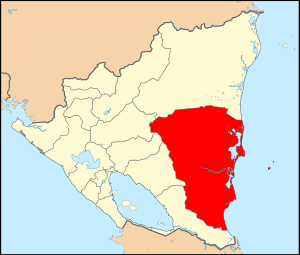South Caribbean Coast Autonomous Region facts for kids
Quick facts for kids
South Caribbean Coast Autonomous Region
Región Autónoma de la Costa Caribe Sur
|
|||
|---|---|---|---|
|
Autonomous region
|
|||
|
|||
| Anthem: Coast Brothers | |||
 |
|||
| Country | |||
| Capital city | Bluefields | ||
| Largest city | Bluefields | ||
| Seat | Bluefields | ||
| Municipalities | |||
| Government | |||
| • Type | Unicameral | ||
| • Body | Regional Council | ||
| Area | |||
| • Total | 27,260.02 km2 (10,525.15 sq mi) | ||
| Area rank | 2nd (20.9% of Nicaragua) | ||
| Population
(2021 estimate)
|
|||
| • Total | 420,935 | ||
| • Density | 15.441478/km2 (39.99324/sq mi) | ||
| ISO 3166 code | NI-AS | ||
| Autonomy Statute | 30 October 1987 | ||
| Official languages | English Creole (Miskito Coast Creole and Rama Cay Creole) Miskito Sumo (Mayangna and Ulwa) Garifuna Rama |
||
| Regional Council | 45 councilors | ||
| National Assembly | 2 deputies (of 92) | ||
The South Caribbean Coast Autonomous Region is one of two special areas in Nicaragua. It's called an autonomous region because it has its own government and rules. This region covers about 27,260 square kilometers. That's a big area!
Around 420,935 people live here, based on a 2021 estimate. The main city and capital is Bluefields. This region is right next to the Caribbean Sea. It includes part of a famous coastal area known as Mosquitia.
The region is split into 12 smaller areas called municipalities. These include Bluefields, the Corn Islands, and Pearl Lagoon. Many languages are spoken here. The most common ones are English Creole and Spanish. The beautiful Pearl Cays islands are also part of this region. They mostly belong to the municipality of Pearl Lagoon.
Contents
What People Do: Economy
Many people in the South Caribbean Coast Autonomous Region work in different industries. These jobs help the country's economy.
Farming and Crops
About 30 out of every 100 workers on the Caribbean Coast are farmers. They grow many important crops. Some of these include oil palm, coconuts, and pineapples. Farmers also grow rice, onions, corn, and different kinds of beans. Other crops like cacao and coffee are also important.
Fishing Industry
Fishing is a very important activity here. It brings a lot of money into the country. Fishermen mostly catch shrimp, lobster, and various types of fish. In 2016, the Caribbean Coast produced 24 million pounds of seafood. Most of this was exported, earning about 126 million US dollars.
Mining for Resources
Mining has been happening in this region for over a hundred years. It involves digging for valuable minerals. The mining sector has been growing since 2010. In 2016, it exported 357 million dollars worth of minerals. Most mining areas are in places like Rosita and Bonanza.
Raising Animals: Livestock and Dairy
The Caribbean Coast is home to 35 out of every 100 cattle in Nicaragua. Nicaragua is a top producer of meat and dairy products in Central America. The amount of meat exported and milk produced has been growing steadily each year.
Forests and Timber
This region has huge forests, covering about 37,394 square kilometers. These forests have valuable trees like mahogany and teak. People use these trees for timber. Since 2003, more trees like teak and mahogany have been planted. Over 100 million US dollars have been invested in the forestry sector from 2014 to 2020.
Getting Around: Infrastructure and Transportation
Good roads, ports, and electricity are important for people and businesses.
Roads and Bridges
Currently, about 300 kilometers of main roads are kept in good condition. There are also about 2,415 kilometers of smaller rural roads. The region has 157 bridges for vehicles and people.
Ports and Airports
The South Caribbean Coast Autonomous Region has one main port for trade. It's called The Bluff. This port is located on the Bluefields Bay. It can only be reached by water. A 100-kilometer water route connects The Bluff to the Rama port along the Escondido River. The port helps guide ships safely.
Electric Power
As of 2016, more than half of the region had electricity. About 52 out of every 100 people had direct access to the national power grid. This means about 313 communities had a steady supply of electricity. Around 30 million US dollars have been invested to improve electricity services.
Air Travel
A local airline called La Costeña offers flights between Managua and the Caribbean Coast. It has daily flights to cities like Puerto Cabezas, Bluefields, and Corn Island. There are also three main cargo terminals for air freight. These are in Puerto Cabezas, Bluefields, and Corn Island.
See also
 In Spanish: Región Autónoma de la Costa Caribe Sur para niños
In Spanish: Región Autónoma de la Costa Caribe Sur para niños



